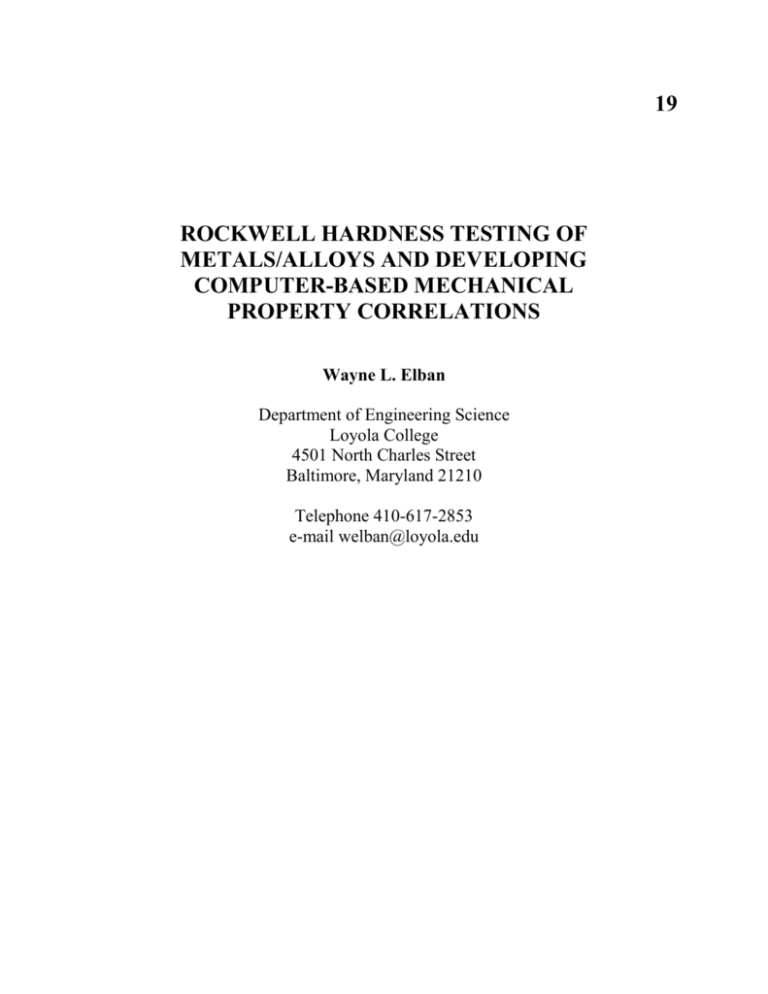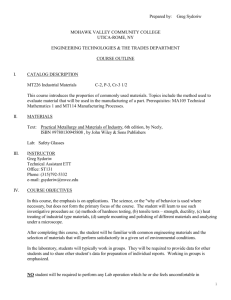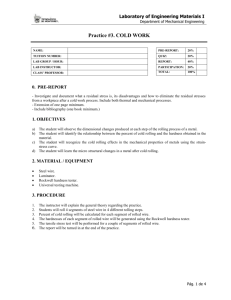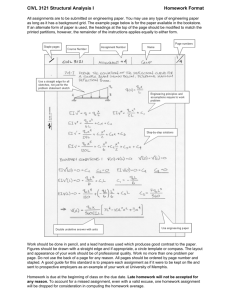
19
ROCKWELL HARDNESS TESTING OF
METALS/ALLOYS AND DEVELOPING
COMPUTER-BASED MECHANICAL
PROPERTY CORRELATIONS
Wayne L. Elban
Department of Engineering Science
Loyola College
4501 North Charles Street
Baltimore, Maryland 21210
Telephone 410-617-2853
e-mail welban@loyola.edu
Rockwell Hardness Testing of Metals/Alloys and
Developing Computer-based Mechanical
Property Correlations
Wayne L. Elban
Department of Engineering Science
Loyola College
Baltimore, Maryland 21210
ABSTRACT: A procedure is described for performing Rockwell (B scale) hardness testing on a
number of non-ferrous and ferrous metals and alloys. Cylindrical ASTM tensile dog bone
samples were used, necessitating data correction because the surfaces tested were curved rather
than flat. Data analysis was accomplished using a spreadsheet and its plotting capability.
Various trends were noted, such as the effect of carbon concentration on hardness and the effect
of processing temperature on hardness in some of the ferrous materials. Cambridge Engineering
Selector software was used to generate plots showing the correlation of various mechanical
properties including tensile strength vs. hardness and Young’s modulus vs. hardness.
KEY WORDS: Rockwell hardness, metals, alloys, mechanical property correlations, Cambridge
Engineering Selector software
PREREQUISITE KNOWLEDGE: sophomore-level undergraduate laboratory experiment
requiring basic knowledge of mechanical properties as described in an introductory materials
science course and accompanying laboratory course.
OBJECTIVES:
(a) Experimental Goals:
1.
2.
to measure the Rockwell hardness (B scale) of various non-ferrous and ferrous
metals and alloys; and
to obtain computer-based mechanical property correlations.
(b) Learning Goals:
1.
2.
3.
4
to become familiar with Rockwell hardness testing, a prominent technique for
characterizing the mechanical response of materials;
to become familiar with performing hardness data correction for round test
samples;
to become familiar with the relative hardness of various metals and alloys; and
to become familiar with the process of creating computer-based mechanical
property correlations for various materials.
EQUIPMENT AND MATERIALS: (1) Instron Wilson Rockwell hardness tester (model
2000R) equipped with a 1/16 in. hardened steel ball indenter; (2) Flat anvil; (3) V-anvil; (4) Steel
block used for seating indenter ball and flat anvil; (5) Wilson calibration block (HRB = 80.46 ±
1.0); (6) Extra steel cylindrical ASTM tensile dog bone sample used for seating V-anvil; (7)
Number of nonferrous and ferrous cylindrical ASTM tensile dog bone samples; (8) Wilson
Correction Chart for testing round samples; (9) Cambridge Engineering Selector software
(Version 4.5).
SAFETY PRECAUTIONS: No particular safety precautions are necessary. However, care
must be taken to avoid moving the sample once the tester commences its operating cycle.
INTRODUCTION: Indentation hardness testing is a widely used “nondestructive” materials
characterization technique. The set-up is easy, the actual test is quite simple to conduct, and the
results are reliable if certain prescribed practices [1,2] are closely followed. In addition, it is
possible to correlate mechanical property determinations obtained by conventional tensile
testing, such as tensile strength and elastic moduli, with hardness values. Tensile testing is
considered destructive because the samples typically are permanently deformed, even fractured;
the experimental arrangement is also more involved, making it more time consuming. Relatively
large sample sizes and standard sheet, plate, or rod geometries are normally required compared
to those needed for hardness testing; here, samples with small sizes or complex geometries can
be tested easily. Indentation hardness testing involves applying a fixed load, P, to an indenter or
penetrator having any one of a variety of shapes, such as a ball, cone, or pyramid (Refer to Table
6.10, Shackelford [3].).
In one approach for such hardness tests as Brinell, Vickers, and Knoop, the resulting
diameter or some characteristic dimension of the residual (plastic) impression put in the surface
of the material being tested is measured optically upon removal of the indenter. This
measurement allows determination of either the contact area, Ac, or projected area, Ap. The
hardness pressure is then computed (Again refer to Table 6.10, Ref. [3].) from either
H = P/Ac,
or
(1)
H = P/Ap, respectively.
In an alternative approach known as Rockwell testing, hardness values are obtained as
direct readings on an analog dial or digital display as a result of measuring the change in depth of
penetration during the test cycle. The Rockwell values using a ball indenter are obtained using
the relationship
R = 130 - 500h,
(2)
where h = indentation depth (mm). A wide range of metallic and nonmetallic materials can be
tested by choosing an appropriate scale, corresponding to a given indenter geometry and load
(Refer to Table 1 on p. 5 in Ref. [2].).
The purpose of the first portion of this experiment was to measure the Rockwell hardness
of a number of nonferrous and ferrous tensile “dog bone” samples machined according to
specifications prescribed by the American Society for Testing and Materials (ASTM) [4].
(Instructor Note 1) The B scale, involving a 1/16 in. hardened steel ball and a total applied load
of 100 kgf, was selected to allow direct comparison of hardness values for the complete sample
set.
As a follow-on activity, material property correlations for a variety of standard
mechanical properties versus hardness were obtained using the Cambridge Engineering Selector
(CES) software. (Instructor Note 2) This exercise is both feasible and worthwhile because
hardness offers a measure of a material’s resistance to penetration that is dependent on such
mechanical properties as tensile strength and strain capacity. In fact, the indenter is frequently
thought of as a “strength probe.”[5]
PROCEDURE:
A. EXPERIMENTAL
1. Rockwell hardness testing
To ensure accurate hardness test results, it is recommended to use a new 1/16 in.
hardened steel ball since balls tend to flatten with use, particularly when high hardness materials
are tested. Once the new ball is inserted, run one hardness test on an expendable material in
order to "seat" the ball in its holder as well as the anvil selected (i.e., flat for the calibration
procedure).
It is also necessary to test a calibration block which is a material having a highly polished
top surface and parallel bottom surface. Such standard reference blocks are available from the
manufacturer of the tester and have a certified hardness specified with an upper/lower variation.
Obtaining a hardness reading within the permitted range of values for the block verifies that the
tester is working properly. Once this has been established, testing samples with unknown
hardnesses can proceed with confidence. However if a large number of samples are being tested,
it is desirable to perform intermediate and/or concluding calibration checks.
Normally, indentation hardness tests are performed on samples with flat surfaces. When
curved surfaces such as those encountered in ASTM dog bones are tested, the values obtained
are low compared to analogous samples with flat surfaces. This occurs because a curved surface
offers less material at the surface in the vicinity of the indentation to act as a constraint as the
region being indented resists penetration by the indenter.
Record measurements and any relevant observations in a laboratory notebook with
appropriate drawings.
(1) Replace the existing 1/16 in. ball with a new one; perform an initial "seating"
experiment with a steel block placed on the flat anvil.
(2) Perform a calibration measurement using the standard reference block (In this case,
HRB = 80.46 ± 1.0.) placed on the flat anvil. If the measurement lies outside the
specified range, repeat the measurement.
(3) Perform a minimum of three (3) hardness tests on the gage length of each sample
listed below using the V-anvil. (Instructor Note 3) Prior to sample testing, the V-anvil
must also be "seated" using the designated “extra” dog bone sample. Be sure to note the
diameter (0.50 or 0.25 in.) of each dog bone sample tested as this information will be
needed to perform a correction to account for the curved surface.
Nonferrous ASTM tensile dog bone samples to be tested are:
(a) magnesium (dark gray or black ends);
(b) copper (red ends);
(c) 2017-T4 aluminum (blue ends);
(d) free machining brass (white ends); and
(e) Naval brass hard (blue ends).
Ferrous ASTM tensile dog bone samples to be tested are:
(a) conventional (not austempered) ductile iron (yellow ends);
(b) gray cast iron (copper ends);
(c) 1018 hot rolled plain carbon steel, having 0.18 wt% carbon (blue/black
ends);
(d) 1018 cold finish plain carbon steel (blue/white ends);
(e) 1040 hot rolled plain carbon steel, having 0.40 wt% carbon (red/black
ends);
(f) 1040 cold finish plain carbon steel (red/white ends);
(g) 1090 hot rolled plain carbon steel, having 0.90 wt% carbon
(silver/black ends);
(h) 4140 hot rolled low alloy steel, having 0.40 wt% carbon plus 0.88 wt%
manganese, 0.95 wt% chromium, and 0.20 wt% molybdenum (green/black
ends); and
(i) 4140 cold finish low alloy steel (green/white ends).
(4) After "re-seating" the flat anvil, perform a follow-up calibration measurement using
the standard reference block (HRB = 80.46 ± 1.0). If the measurement lies outside the
specified range, repeat the measurement.
(5) Using Table 7 on p. 12 in Ref. [6], perform the appropriate hardness data correction
needed when testing curved rather than flat surfaces. All of the dog bone samples had
nominal diameters of 0.5 in. except for the aluminum alloy sample which had a 0.25 in.
diameter. (Instructor Note 4)
2. Computer-based mechanical property correlations
Among its many capabilities, the CES software can easily provide linear or logarithmic
plots of property A (appearing on y-axis) versus property B (appearing on x-axis) for a variety of
metallic and non-metallic materials.[7] With such plots, it is possible to establish many
interesting material property correlations. How property A varies with property B is easily
visualized for all of the materials included in the software's database, and where specific
materials lie on the plot can be conveniently identified and annotated.
Print each plot for taping into your notebook and turn in a copy with the laboratory
reporting exercise.
(1) Prepare the following logarithmic plots using the CES software operating at Level
I/II:
(a) elastic limit (usually similar to yield point) vs. Vickers hardness, which is
available on the software and somewhat analogous to Rockwell hardness;
(b) tensile strength vs. Vickers hardness;
(c) elongation vs. Vickers hardness; and
(d) Young's modulus vs. Vickers hardness.
(2) For each plot, locate and label the following materials:
(a) aluminum alloys;
(b) copper alloys;
(c) low carbon (or plain carbon) steel; and
(d) low alloy steel.
B. ANALYSIS
Perform the following analyses and respond to any questions as completely as possible
being sure to show all of your work and reasoning as partial credit can be earned.
1. Rockwell hardness testing
a.
Using Excel (or equivalent), perform the following analysis for each sample: (1)
tabulate the Rockwell hardness (B scale) values; and (2) calculate the average and
standard deviation [8]. (Note: Standard deviation is a statistical parameter that
characterizes the uncertainties associated with the experimental attempts to determine
the “true” value of hardness for a given material. The standard deviation gives a
measure of the uncertainty due to fluctuations in the hardness values.)
b.
Using Excel (or equivalent), create a properly labeled linear plot of Rockwell
hardness (B scale) versus wt% carbon for the hot rolled 1018, 1040, and 1090 steels.
Discuss the trend that exists.
c.
Discuss the relative ordering of the hardness values measured for the nonferrous
versus ferrous metals and alloys. Comment on whether this same trend is observed in
your CES plots by considering the hierarchy of Vickers hardness values appearing
along the x-axis.
d.
Discuss the relative ordering of the hardness values measured for the two iron
samples versus the 1018 steel samples.
e.
For both 1018 and 1040 steel samples, discuss the relative ordering of the hardness
values measured for hot rolled versus cold finish.
f.
Discuss the effect that adding small amounts of various transition elements to 1040
steel (1.0 wt% Cr and 0.20 wt% Mo in particular to create 4140 steel) has on its
hardness. Consider both hot rolled and cold finish materials.
2. Computer-based mechanical property correlations
a.
Referring to your CES plot of elastic limit versus Vickers hardness, discuss any trend
that exists.
b.
Referring to your CES plot of tensile strength versus Vickers hardness, discuss any
trend that exists.
c.
Referring to your CES plot of elongation versus Vickers hardness, discuss any trend
that exists.
d.
Referring to your CES plot of Young’s modulus versus Vickers hardness, discuss any
trend that exists.
COMMENTS with Sample Data Sheet and Plot:
All of the experimental steps were typically performed at least twice to verify that the results are
reasonably reproducible. The data appearing in this section are considered to be representative.
Rockwell hardness testing: The measured hardness values and their averages with corresponding
standard deviations appear in Table I, where it is possible to gain a number of insights about the
materials that were tested. A plot (Figure 1) of average HRB vs. wt% carbon for the three hotrolled steels shows hardness increasing non-linearly with increasing carbon content and the slope
of the line decreasing as the amount of carbon increases. The hardness values for the nonferrous
metals and alloys is less than those for the ferrous materials in agreement with the CES plots to
be discussed in the next section.
Considering the two iron and 1018 steel samples, the hardness ordering is cast iron >
ductile iron > 1018. While a considerable range in hardness values is possible for the two iron
materials because of such differences as chemical composition, solidification process, and
subsequent heat treatment, their arrangement is consistent with reported [9] ranges in Brinell
hardness. In addition, the ordering for all three materials is consistent with hardness ranges
specified by the manufacturer as provided by Peter Bowers, Kevco Industries.[10]
Table I. Compilation of Rockwell (B Scale) Hardness Results
Material
HRB1
HRB2
HRB3
HRB4
HRB5
HRB6
Avg.
CF
New
Avg.
Std.
Dev.
47.5
25.9
56.1
51.3
30.3
57.4
47.6
23.6
53.8
51.2
26.8
54.2
49.2
30.5
55.8
44.1
29.6
51.9
48.5
27.8
54.9
4.1
5.1
7.5
52.6
32.9
62.4
2.7
2.8
2.0
65.4
66.4
82.8
90.9
69.1
76.4
88.2
97.7
100.1
85.4
91.0
65.3
66.2
83.8
91.8
65.5
75.8
86.3
98.3
100.6
84.8
89.8
64.2
66.3
82.5
93.3
69.1
74.3
87.3
98.0
100.8
82.3
93.3
65.0
65.8
86.0
91.6
69.1
77.9
88.4
98.3
101.1
80.3
88.2
67.1
67.2
84.2
90.6
71.1
77.7
85.1
97.9
101.0
85.1
90.2
65.2
64.7
84.0
90.4
69.4
74.7
85.4
98.6
101.1
82.0
92.7
65.4
66.1
83.9
91.4
68.9
76.1
86.8
98.1
100.8
83.3
90.9
3.2
3.2
2.3
1.9
3.1
2.7
2.2
1.6
1.5
2.3
2.0
68.6
69.3
86.2
93.4
71.9
78.8
88.9
99.7
102.2
85.7
92.8
1.0
0.8
1.2
1.1
1.8
1.5
1.4
0.3
0.4
2.1
1.9
Magnesium
Copper
2017-T4 aluminum
Free machining
brass
Naval brass hard
Ductile iron
Cast iron
1018 HR steel
1018 CF steel
1040 HR steel
1040 CF steel
1090 HR steel
4140 HR steel
4140 CF steel
120.0
100.0
HRB
80.0
y = -70.379x 2 + 118.09x + 52.924
R2 = 1
60.0
40.0
20.0
0.0
0.00
0.20
0.40
0.60
0.80
Wt% C
Figure 1. Effect of carbon concentration on Rockwell (B scale) hardness
for hot rolled plain carbon steel.
1.00
Reflecting a higher degree of work hardening, the cold finish 1018 and 1040 steels have
higher hardness values than their hot rolled counterparts; a greater difference was obtained for
the steel with the higher carbon content. Compared to 1040 steel, 4140 low alloy steel had a
surprisingly lower hardness for both the hot rolled and cold finish materials. This unexpected
result is most likely caused by a difference in processing conditions for the materials used to
make these samples.
Computer-based mechanical property correlations: The logarithmic plot of elastic limit vs.
Vickers hardness in Figure 2 shows a strong correlation with elastic limit increasing as hardness
increases. The hardness hierarchy for the labeled materials is aluminum alloys < copper alloys <
low carbon steel < low alloy steel with some overlap in the range of values plotted. Here, the
ordering for the low carbon and low alloy steels is as expected. Since elastic limit is defined as
the highest stress that a material still deforms elastically, it may seem surprising that the two
properties relate so well because Vickers hardness is measure of a material’s ease to plastically
deform in accommodating the indenter. However, a strong correlation exists between elastic
limit and yield strength which is the stress practically used to identify where plastic deformation
commences.
Aluminium alloys
100
Elastic Limit (ksi)
10
Low alloy steel
1
Copper alloys
Low carbon steel
0.1
0.01
1e-3
0.01
0.1
1
10
100
1000
Hardness - Vickers (HV)
Figure 2. CES plot of elastic limit vs. Vickers hardness.
A similar correlation exists between elastic limit and tensile strength, which is defined as
the highest sustained load divided by the initial load bearing area. Thus, it is not surprising that
an analogous correlation exists between tensile strength and Vickers hardness (Figure 3). This
particular material property relationship has been evaluated in detail because of the desire to
obtain tensile strength values for samples whose geometry/size readily allows hardness testing
but is highly inconvenient for uniaxial tensile testing.[11,12]
Low alloy steel
Aluminium alloys
Tensile Strength (ksi)
100
Low carbon steel
10
Copper alloys
1
0.1
1e-3
0.01
0.1
1
10
100
1000
Hardness - Vickers (HV)
Figure 3. CES plot of tensile strength vs. Vickers hardness.
With the exception of polymers (e.g., polyethylene) and ceramics (e.g., alumina),
elongation (i.e., strain capacity) is relatively insensitive to changes in Vickers hardness within
the range of values plotted (Figure 4) for various materials. However, a strong correlation does
exist between Young’s modulus and Vickers hardness (Figure 5). An analogous correlation was
reported by Gilman [13] for face-centered cubic metals and attributed to hardness being closely
associated with dislocation interactions which are elastic.
INSTRUCTOR NOTES:
1. The current hardness experiment relates to several previous years’ NEW papers [14-17] on
various aspects of hardness testing. Of these papers, the one by Martin and Lash [15] involves
traditional ball indentation testing (i.e., Brinell) and correlations between ultimate tensile
strength and various hardness scales.
2. Use of the CES software was the topic of two NEW papers [18,19] delivered in 2003.
3. A subset of the samples is provided to each group of three or four students, allowing them to
obtain their own results to be shared with the entire lab class. To improve statistical validity, the
data sets obtained by multiple lab classes can be combined and used by everyone in their data
analysis and discussion of results.
Copper alloys
Low alloy steel
Polyethylene (PE)
Low carbon steel
Elongation (%)
100
10
1
Alumina
Aluminium alloys
0.1
1e-3
0.01
0.1
1
10
100
1000
Hardness - Vickers (HV)
Figure 4. CES plot of elongation vs. Vickers hardness.
100
Low carbon steel
Copper alloys
Young's Modulus (10^6 psi)
10
Low alloy steel
1
0.1
Aluminium alloys
0.01
1e-3
1e-4
1e-3
0.01
0.1
1
10
100
1000
Hardness - Vickers (HV)
Figure 5. CES plot of Young’s modulus vs. Vickers hardness.
INSTRUCTOR NOTES, Continued:
4. Discrete cylindrical correction data points are given in Ref. [6] for Rockwell hardness B scale
values ranging from 0 to 100 in increments of 10. To utilize for the current experimental
hardness values, interpolation is recommended by Willard Corby, Associate Technical Support
Engineer with Instron Wilson.[20] Alternatively, the same data correction can be accomplished
from a least-squares fit analysis using Excel (or equivalent) to obtain an equation of the line for a
linear plot of correction factor (CF) vs. Rockwell hardness B scale (HRB). For 0.5 in. round
stock, the equation was determined to be CF = -0.05 HRB + 6.5, while for the 0.25 in. round
stock, the equation was CF = -0.1 HRB + 13, for HRB values ranging from 10 to 90.
REFERENCES:
[1]
“Standard Test Methods for Rockwell Hardness and Rockwell Superficial Hardness of
Metallic Materials,” Designation E 18-84, in 1986 Annual Book of ASTM Standards,
Volume 03.01 Metals–Mechanical Testing; Elevated and Low-Temperature Tests.
ASTM, pp.194-218.
[2]
Low, S.R.: Rockwell Hardness Measurement of Metallic Materials, NIST Recommended
Practice Guide, Special Publication 960-5, January 2001.
[3]
Shackelford, J.F.: Introduction to Materials Science for Engineers, 6th Edn., Pearson
Prentice Hall, Upper Saddle River, New Jersey, 2005, p. 221.
[4]
“Standard Test Methods for Tension Testing of Metallic Materials,” Designation E 885b, in 1986 Annual Book of ASTM Standards, Volume 03.01 Metals–Mechanical
Testing; Elevated and Low-Temperature Tests. ASTM, p.139.
[5]
Gilman, J.J.: Hardness–A Strength Microprobe, in The Science of Hardness Testing and
Its Research Applications, American Society for Metals, 1973, pp. 51-74.
[6]
“Fundamentals of Rockwell Hardness Testing,” Wilson Instruments, Binghamton, New
York, 1998.
[7]
Ashby, M.F.; and Cebon, D.: New Approaches to Materials Education for Students of
Engineering, in Proceedings of the 2003 American Society for Engineering Education
Annual Conference and Exposition, 2003, Session Number 2464.
[8]
Holman, J.P.: Experimental Methods for Engineers, 7th Edn., McGraw-Hill Book Co.,
2001, pp. 62-63.
[9]
Budinski, K.G.; and Budinski, M.K.: Engineering Materials: Properties and Selection, 8th
Edn., Pearson Prentice Hall, Upper Saddle River, New Jersey, 2005, p. 605.
[10]
Bowers, P.C.: Private Communication, June 9, 2005.
[11]
“Hardness Tests,” Metals Handbook, American Society for Metals, 1960, pp. 98-105.
[12]
“Fundamentals of Rockwell Hardness Testing,” op. cit., p. 11.
[13]
Gilman, J.J.: op. cit., pp. 60-61.
[14]
Widener, E.L.: It’s Hard to Test Hardness, in National Educators' Workshop: Update 90,
NIST Special Publication 822, 1991, pp. 161-167.
[15]
Martin, D.H.; and Lash, B.: Application of Hardness Testing in Foundry Processing
Operations: A University and Industry Partnership, in National Educators' Workshop:
Update 92, NASA Conference Publication 3201, 1993, pp. 221-232.
[16]
Olesak, P.J.; and Widener, E.L.: Scleroscope Hardness Testing, in National Educators'
Workshop: Update 93, NASA Conference Publication 3259, 1994, pp. 451-455.
[17]
Spiegel, F.X.; and West, H.A.: A Novel Approach to Hardness Testing, in National
Educators' Workshop: Update 95, NASA Conference Publication 3330, 1996, pp. 323328.
[18]
R.B. Griffin: Use of Cambridge Engineering Selector in a Materials/Manufacturing
Course, in National Educators' Workshop: Update 2003, NASA/CP-2004-213243/PT2,
September 2004, pp. 595-604.
[19]
S.L. Kampe: Incorporating Green Engineering in Material Selection and Design, in
National Educators' Workshop: Update 2003, NASA/CP-2004-213243/PT2, September
2004, pp. 711-730.
[20]
Corby, W.: Private Communication, February 18, 2005.
SOURCES OF SUPPLIES: A variety of cylindrical ASTM tensile dog bone samples are
available from Kevco Industries, 6 Milbrook Road, New Paltz, New York 12561; phone (845255-7407); FAX (845-256-9256); e-mail (kevco269@aol.com); Web site (eeeco.com). The CES
software is available from GRANTA DESIGN LIMITED, Rustat House, 62 Clifton Road,
Cambridge, CB1 7EG, United Kingdom; phone (800-241-1546); FAX (216-274-9812).
ACKNOWLEDGEMENTS: The identification of any manufacturer and/or product does not
imply endorsement or criticism by the author or Loyola College.
Wayne L. Elban
Since 1985, Professor Elban has taught engineering science courses at Loyola College,
including introductory materials science, materials science lab, mechanical properties of
materials, transformations in solids, and engineering materials and manufacturing processes. He
received a BChE with distinction ('69) and a PhD in Applied Sciences: Metallurgy ('77) from the
University of Delaware and a MS in Engineering Materials ('72) from the University of
Maryland, College Park. From 1969-1985, he was a research engineer at the Naval Surface
Warfare Center, White Oak Laboratory, Silver Spring, Maryland. In 1992, he was a Fulbright
scholar at the University of Strathclyde (Glasgow), Department of Pure and Applied Chemistry.
From 2001-2003, he was a working visitor at the Smithsonian Center for Materials Research and
Education. He is a member of ASM International and the Society of Manufacturing Engineers.






